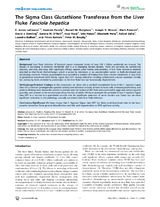The Sigma Class Glutathione Transferase from the Liver Fluke Fasciola hepatica

Ver/
Autor
LaCourse, E. James
Perally, Samirah
Morphew, Russell M.
Moxon, Joseph V.
Prescott, Mark
Dowling, David J.
O'Neill, Sandra M.
Kipar, Anja
Hetzel, Udo
Hoey, Elizabeth
Brophy, Peter M.
Pérez, José
Zafra Leva, Rafael
Buffoni Perazzo, Leandro
Editor
Public Library Of Science (PLOS)Fecha
2012Materia
Liver flukeFasciola hepatica
Livestock
METS:
Mostrar el registro METSPREMIS:
Mostrar el registro PREMISMetadatos
Mostrar el registro completo del ítemResumen
Background: Liver fluke infection of livestock causes economic losses of over US$ 3 billion worldwide per annum. The
disease is increasing in livestock worldwide and is a re-emerging human disease. There are currently no commercial
vaccines, and only one drug with significant efficacy against adult worms and juveniles. A liver fluke vaccine is deemed
essential as short-lived chemotherapy, which is prone to resistance, is an unsustainable option in both developed and
developing countries. Protein superfamilies have provided a number of leading liver fluke vaccine candidates. A new form
of glutathione transferase (GST) family, Sigma class GST, closely related to a leading Schistosome vaccine candidate (Sm28),
has previously been revealed by proteomics in the liver fluke but not functionally characterised.
Methodology/Principal Findings: In this manuscript we show that a purified recombinant form of the F. hepatica Sigma
class GST possesses prostaglandin synthase activity and influences activity of host immune cells. Immunocytochemistry and
western blotting have shown the protein is present near the surface of the fluke and expressed in eggs and newly excysted
juveniles, and present in the excretory/secretory fraction of adults. We have assessed the potential to use F. hepatica Sigma
class GST as a vaccine in a goat-based vaccine trial. No significant reduction of worm burden was found but we show
significant reduction in the pathology normally associated with liver fluke infection.
Conclusions/Significance: We have shown that F. hepatica Sigma class GST has likely multi-functional roles in the hostparasite
interaction from general detoxification and bile acid sequestration to PGD synthase activity.
